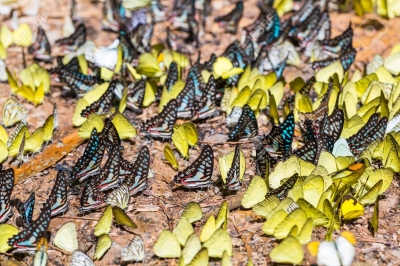
Some insects engage in what is called mud puddling or puddling. This behaviour is most commonly witnessed among butterflies, and many species do this. So, what exactly is mud puddling, and why do butterflies do it?
Mud puddling is a phenomenon where butterflies across many species gather (sometimes together) on the wet soil and drink up the fluid. Since butterfly food is usually nectar, (and in a few cases, tree sap or some organic matter), it is deficient in nutrients. And that is what the fluid consumed through mud puddling gives them; the butterflies take in salts (including sodium) and minerals during this ritual. According to a study, many butterflies “eject surplus water, confirming that substances dissolved in water, rather than water itself, are the principal resource accumulated through paddling”. Puddling is found widely among many butterfly species in the tropical regions, and is said to happen after the monsoon. It’s been recorded that predominantly males are engaged in this ritual rather than females, linking the phenomenon to reproduction. It is believed that the male, stocked up on nutrients, passes on some of those to the female, helping with stronger eggs and healthier newborns.
Interestingly, mud is not the only source of nutrients during puddling. It could be obtained from decaying organic matter, animal and human urine, puddles, and even sweat.
Did you know?
It has been found that even tears are a source of nutrients for the butterflies. For instance, it has been recorded in the Amazon that butterflies drink the tears of turtles. Apparently, far as they are from the salt-laden Atlantic Ocean, waters in the western Amazon region are low in sodium. The tears are said to be an important source of salt, especially sodium, for the butterflies. Though this butterfly act does not seem to injure the turtles, too many of them around the reptile’s eyes could obstruct the latter’s vision a bit. Also, not just butterflies, even bees seem to be helping themselves to turtle tears.
Picture Credit : Google



